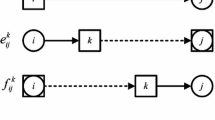Abstract
We consider the combined hubbing and routing problem in postal delivery systems and develop an iterative two-stage solution procedure for the problem. In the first stage, hub locations are determined and postal offices are multiply allocated to the hubs. The second stage gives the routes in hub regions that alter the distances between points used in the hub-location problem. The procedure then iterates between two stages by updating the distances used in hubbing in order to produce a route-compatible hub configuration. Computational experience is reported for the test problems taken from the literature. For a case study Turkish postal delivery system data are utilized. As the case study is applied on a road network, a final stage, seeking improvements based on special structures in the routed network, is appended to the two-stage solution procedure.
Similar content being viewed by others
References
Aykin, T. (1995). Networking policies for hub-and-spoke systems with application to the air transportation system. Transportation Science, 29, 201–221.
Boland, N., Krishnamoorthy, M., Ernst, A. T., & Ebery, J. (2004). Preprocessing and cutting for multiple allocation hub location problems. European Journal of Operational Research, 155, 638–653.
Bookbinder, J. H., & Reece, K. E. (1988). Vehicle routing considerations in distribution system design. European Journal of Operational Research, 37, 204–213.
Bruns, A., Klose, A., & Stähly, P. (2000). Restructuring of swiss parcel delivery services. OR-Spectrum, 22, 285–302.
Campbell, J. F. (1994). Integer programming formulations of discrete hub location problems. European Journal of Operational Research, 72(2), 387–405.
Campbell, J.F. (1996). Hub location and the p-hub median problem. Operations Research, 44, 923–935.
Campbell, J. F., Ernst, A. T., & Krishnamoorthy, M. (2001). Hub location problems. In Z. Drezner, & H. W. Hamacher (Eds.), Facility location, applications and theory (pp. 373–407). Berlin: Springer.
Çetiner, S. (2003). An iterative hub location and routing problem for postal delivery systems. MS Thesis, METU Ankara.
Clarke, G., & Wright, J. W. (1964). Scheduling of vehicles from a central depot to a number of delivery points. Operations Research, 12, 568–581.
Daskin, M. S. (1995). Network and discrete location: models, algorithms and applications. New York: Wiley.
Ernst, A. T., & Krishnamoorthy, M. (1996). Efficient algorithms for the uncapacitated single allocation p-hub median problem. Location Science, 4(3), 139–154.
Ernst, A. T., & Krishnamoorthy, M. (1998). An exact solution approach based on shortest-paths for p-hub median problems. Journal on Computing, 10(2), 149–162.
Fisher, M. (1994). Optimal solution of vehicle routing problems using minimum K-trees. Operations Research, 42, 626–642.
Fotheringham, A. S. (1983). A new set of spatial interaction models: The theory of competing destinations. Environment and Planning A, 15–36.
Gribkovskaia, I., Halskau, Ø., Laporte, G., & Vlček, M. (2007). General solutions to the single vehicle routing problem with pickups and deliveries. European Journal of Operational Research, 180, 568–584.
Grünert, T., & Sebastian, H. J. (2000). Planning models for long-haul operations of postal and express shipment companies. European Journal of Operational Research, 122, 289–309.
Irnich, S. (2000). A multi-depot pickup and delivery problem with a single hub and heterogeneous vehicles. European Journal of Operational Research, 122, 310–328.
Klincewicz, J. (2002). Enumeration and search procedures for a hub location problem with economies of scale. Annals of Operations Research, 110, 107–122.
Kuby, M. J., & Gray, R. G. (1993). The hub network design problem with stopovers and feeders: The case of federal express. Transportation Research Part A, 27(1), 1–12.
Laporte, G., Nobert, Y., & Pelletier, P. (1983). Hamiltonian location problems. European Journal of Operational Research, 12, 82–89.
Maheshwari, B. E. (2004). A network design model for multi-zone truckload shipments. MS Thesis, Texas A&M University.
Marsten, R. E., & Muller, M. R. (1980). A mixed-integer programming approach to air cargo fleet planning. Management Science, 26(11), 1097–1107.
Metters, R. D. (1996). Interdependent transportation and production activity at the united states postal service. Journal of Operational Research Society, 47(1), 27–37.
Miller, C. E., Tucker, A. W., & Zemlin, R. A. (1960). Integer programming formulation traveling salesman problems. Journal of Association for Computing Machinery, 7, 326–329.
Nagy, G., & Salhi, S. (1996). Nested heuristic methods for the location-routing problem. Journal of Operational Research Society, 47, 1166–1174.
Nagy, G., & Salhi, S. (1998). The many-to-many location-routing problem. TOP, 6, 261–275.
Nagy, G., & Salhi, S. (2007). Location-routing: issues, models and methods. European Journal of Operational Research, 177, 649–672.
Nambiar, J. M., Gelders, L. F., & Van Wassenhove, L. N. (1981). A large scale location-allocation problem in the natural rubber industry. European Journal of Operational Research, 6, 183–189.
O’Kelley, M. E., & Bryan, D. (2002). Interfacility interaction in models of hub and spoke networks. Journal of Regional Science, 42, 145–164.
Or, I., & Pierskalla, W. P. (1979). A transportation location-allocation model for regional blood banking. AIIE Transactions, 11(2), 86–95.
Rosenfield, D. B., Engelstein, I., & Feigenbaum, D. (1992). An application of sizing service territories. European Journal of Operational Research, 63, 164–172.
Skorin-Kapov, D., Skorin-Kapov, J., & O’Kelly, M. E. (1996). Tight linear programming relaxations of uncapacitated p-hub median problems. European Journal of Operational Research, 94(3), 582–593.
Tsigirilides, T. (1984). Heuristic methods applied to orienteering. Journal of the Operational Research Society, 35, 797–809.
Wasner, M., & Zäpfel, G. (2004). An integrated multi-depot hub-location vehicle routing model for network planning of parcel service. International Journal of Production Economics, 90, 403–419.
Watson-Gandy, C., & Dohrn, P. (1973). Depot location with Van Salesmen—A practical approach. Omega, 3, 321–329.
Wu, T.-H., Low, C., & Bai, J.-W. (2002). Heuristic solution to multi-depot location-routing problems. Computers and Operations Research, 29, 1393–1415.
Author information
Authors and Affiliations
Corresponding author
Rights and permissions
About this article
Cite this article
Çetiner, S., Sepil, C. & Süral, H. Hubbing and routing in postal delivery systems. Ann Oper Res 181, 109–124 (2010). https://doi.org/10.1007/s10479-010-0705-2
Published:
Issue Date:
DOI: https://doi.org/10.1007/s10479-010-0705-2




